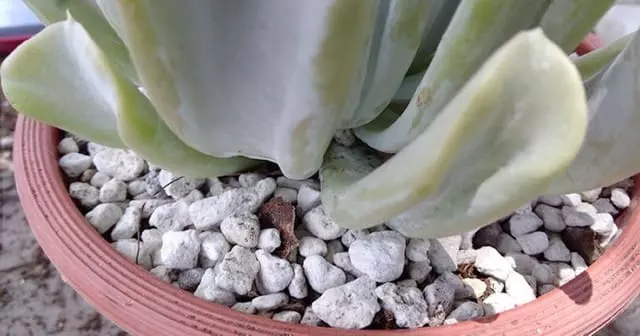This time I want to tell you about an Echeveria that stands out for the beauty of its colors and the size that can reach its rosette, so let’s know the care of the beautiful Echeveria runyonii cultivar. Learn all about Echeveria runyonii cultivar care in this article.
Before I start I want to clarify that this Echeveria is a succulent that arises from a mutation derived from Echeveria runyonii, so they are not found in the wild.
Table of Contents
Characteristics of Echeveria runyonii cultivar “Topsy Turvy”.
Echeveria runyonii cultivar arose in California, United States derived from the mutation of Echeveria runyonii which is a succulent native to Mexico, specifically the states of Tamaulipas and Nuevo Leon.
It belongs to the Crassulaceae family and has a beautiful grayish green tone which, to a great extent, is due to the pruina that covers its leaves.
Its leaves are elongated, curved, and end in a point forming a rosette that, in adult specimens, can reach a diameter of up to 10″ (25 cm).
And if you like succulents that do not take so long to grow, the Echeveria “Topsy Turvy” is an ideal choice, because it develops quickly compared to other succulents.
- Topsy Turvy Succulent Plant - Echeveria runyonii - Easy to grow - 4" Pot
- 811332034867
- Water when dry
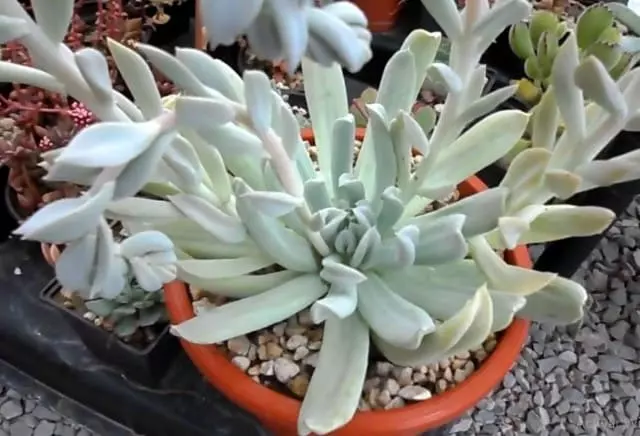
Care of the Echeveria runyonii cultivar
Light:
Echeveria runyonii cultivar is a succulent that burns very easily, so I recommend that you give it very good lighting, but indirectly.
An indicator that will be warning you that your plant is burning is that the tips of its leaves begin to turn brown and dry out.
Because of this characteristic, although it is not very advisable to have plants indoors, this Echeveria can thrive indoors by placing it near a good source of light such as a window.
Watering:
The watering to give to this Echeveria runyonii cultivar is standard, water it every time its substrate is completely dry.
If you have it outdoors you can try watering it every 5 or 7 days at depth, this will be determined by the type of substrate that you have placed and the climate of the area where you live.
Indoors you can water it on average every 15 days.
And if you want its pruina to remain intact, remember to water it directly on the substrate and not on its leaves.
Remember to reduce watering in autumn, and in winter providing it with water once a month will be enough.
Temperature:
Echeveria runyonii cultivar does very well in warm environments, preferably 96 °F (26°C) and above.
It can withstand temperatures below 50 °F (10°C), but it is recommended not to expose it to frost or lower temperatures constantly, as they can weaken the plant and make it susceptible to pest attacks.
Substrate:
The secret to keeping your Echeveria runyonii cultivar beautiful and healthy is to place it on a substrate that is very draining and does not clump or clump.
For my Echeveria runyonii cultivar I have used a mix made up of 60% topsoil and 40% garden soil or black soil and they have grown quite well.
I also like to add a few teaspoons of pulverized charcoal and ground eggshell to the mix.
If you have on hand or can easily get worm castings, all the better, as this compost is very beneficial to the Echeverias.
Remember that you can use the combination that best suits your climate, just make sure that the substrate drains very well and it will work without problems.
- Provides the drainage cacti need to flourish.
- You will receive (1) 4-quart bag with this order.
- Ready to use, so that you don’t need to take the time and energy to mix ingredients together.
Fertilization:
This succulent I recommend that you fertilize in the spring to summer seasons so that it takes full advantage of the nutrients you are going to provide it with.
This fertilization can be done with banana peel tea, worm humus, or worm leachate.
If in your mixture of the substrate you added some of the components that I mentioned to you it will no longer be necessary to fertilize your Echeveria.
- LIGHT APPLICATIONS - A balanced mix of essential nutrients with low NPK rates to gently feed your live cacti and succulents. It help enhance root development, color vibrancy, beautiful bloom, and stem growth in both plant types.
- LASTS LONGER, FOR LESS - Easy, ready to use granular formula feeds your plants consistently for 9 months! Simply poke holes or sprinkle around your pot mix, water, and watch your succulent/cactus thrive! Perfect for pots with pumice, pebbles, gravel, perlite, and other organic potting soil mixes.
- LIQUID ALTERNATIVE - Excellent alternative to liquid fertilizer in a spray bottle. Great for houseplants that need consistent nutrition year round but less watering.
How to Propagate Echeveria runyonii cultivar
One of the most beautiful features of this Echeveria runyonii cultivar is its ease of propagation and we can do it by two simple methods:
Propagate Echeveria runyonii cultivar by Tillers:
This Echeveria usually puts out many offspring, these will sprout from the base of the mother plant.
An additional tip, plant this type of Echeveria in a wide pot, even if it is not very high, as it does not develop long roots, but it will help to have enough space to grow and sprout its offspring.
If you want to know more about the pots you can use with your succulents you may be interested in this article Pots for succulents.
To separate the offspring just wait until they are ¼ of the size of the mother plant, to ensure their survival when you separate them and plant them in their respective pots.
Remember that when you separate them, let their stems heal for at least 3 days, then you can plant them.
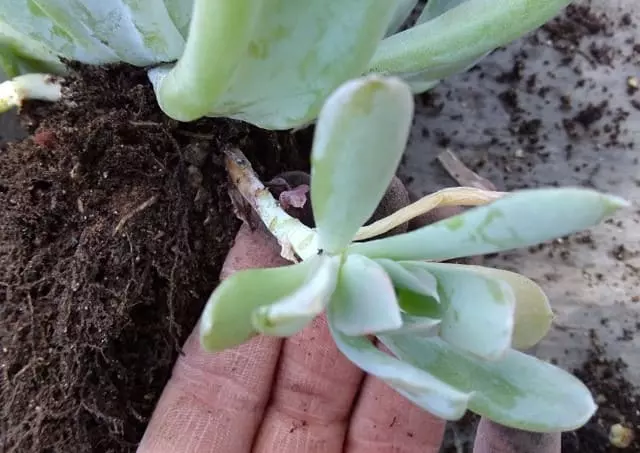
Propagate Echeveria runyonii cultivar by Leaf:
To propagate this Echeveria runyonii cultivar by leaf I recommend that you use a sharp object because the leaves do not detach so easily and we can break them.
So select healthy leaves of good size and cut trying to bring you the whole leaf without leaving even a little piece stuck to the stem.
Once you have done this just place your leaves on a layer of substrate, without burying them, in a place where they do not get direct sunlight and are ready to wait for them to develop rosette and root.
When you see that they already have their first roots you can start watering them with the help of an atomizer.
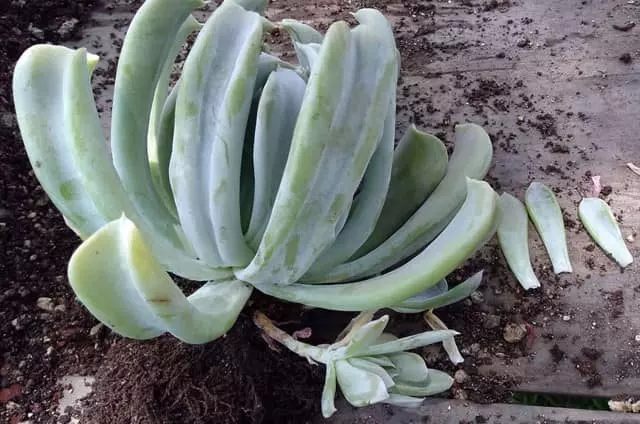
Flowering Echeveria runyonii cultivar:
This Echeveria usually blooms in late summer, these flowers are arranged in a cluster arising from the sides of the plant.
Its flowers are very showy, large and can be orange, red or pink.
The stem that holds the flower cluster can measure up to 30 centimeters in height, my Echeveria runyonii cultivar has given me up to 4 stems per plant, so you will not lack flowers.
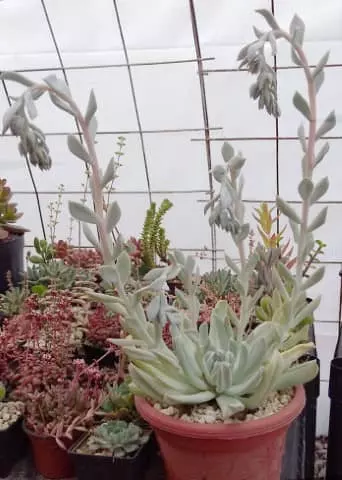
Frequent Problems in The Echeveria runyonii cultivar:
To prevent the development of diseases in our Echeveria, we must ensure that the place where we place it has good ventilation, thus avoiding the appearance of fungi due to excess moisture.
It can be susceptible to the attack of cottony mealybug, aphids, and in the rainy season of snails.
So I recommend that you try to check your plant from time to time to detect any appearance of pests in time and combat them without problems.
In the rainy season, if your plants are outdoors you can place beer traps that help a lot to attract snails so they do not devour your Echeveria runyonii cultivar.
We hope this article on how to care for Echeveria runyonii cultivar will be helpful. We recommend our article about Sempervivum calcareum Care (houseleek).
